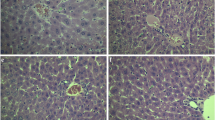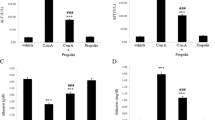Abstract
Introduction
Sodium tanshinone IIA sulfonate (STS) is a water-soluble derivative of tanshinone IIA, the main pharmacologically active component of Salvia miltiorrhiza. The aim of this study was to investigate the effect of STS on concanavalin A (ConA)-induced hepatitis (CIH) in mice, an experimental model of immune-mediated liver injury.
Results
C57BL/6 mice pretreated with STS released much less alanine transaminase into plasma in response to ConA challenge and had reduced inflammatory infiltration and hepatocyte apoptosis in the liver compared with control mice pretreated with vehicle solutions. Thus, STS protected mice from CIH. In STS-pretreated mice induced with CIH, we found abrogated tumor necrosis factor-α and interferon (IFN)-γ production. Moreover, mRNA expressions of IFN-inducible protein-10 and macrophage inflammatory protein-1α in these mice were decreased. The mechanism of anti-inflammatory effects of STS may be attributed to its modulation of crucial inflammatory signaling pathways, including NF-κB and IFN-γ/STAT1.
Conclusion
In conclusion, STS was capable of protecting mice from immune-mediated liver injury in vivo, and the protection was associated with its suppressive effect on the production of important inflammatory mediators through modulating NF-κB and IFN-γ/STAT1 signaling pathways.







Similar content being viewed by others
References
Hazra B, Das Sarma M, Sanyal U. Separation methods of quinonoid constituents of plants used in Oriental traditional medicines. J Chromatogr B Analyt Technol Biomed Life Sci. 2004;812:259–75.
Zhou L, Zuo Z, Chow MS. Danshen: an overview of its chemistry, pharmacology, pharmacokinetics, and clinical use. J Clin Pharmacol. 2005;45:1345–59.
Wang J, Wang X, Jiang S, Yuan S, Lin P, Zhang J, et al. Growth inhibition and induction of apoptosis and differentiation of tanshinone IIA in human glioma cells. J Neurooncol. 2007;82:11–21.
Wu TW, Zeng LH, Fung KP, Wu J, Pang H, Grey AA, et al. Effect of sodium tanshinone IIA sulfonate in the rabbit myocardium and on human cardiomyocytes and vascular endothelial cells. Biochem Pharmacol. 1993;46:2327–32.
Li W, Li J, Ashok M, Wu R, Chen D, Yang L, et al. A cardiovascular drug rescues mice from lethal sepsis by selectively attenuating a late-acting proinflammatory mediator, high mobility group box 1. J Immunol. 2007;178:3856–64.
Tiegs G, Hentschel J, Wendel A. A T cell-dependent experimental liver injury in mice inducible by concanavalin A. J Clin Invest. 1992;90:196–203.
Mizuhara H, O’Neill E, Seki N, Ogawa T, Kusunoki C, Otsuka K, et al. T cell activation-associated hepatic injury: mediation by tumor necrosis factors and protection by interleukin 6. J Exp Med. 1994;179:1529–37.
Gantner F, Leist A, Lohse W, Germann PG, Tiegs G. Concanavalin A-induced T-cell-mediated hepatic injury in mice: the role of tumor necrosis factor. Hepatology. 1995;21:190–8.
Kusters S, Gantner F, Kunstle G, Tiegs G. Interferon gamma plays a critical role in T cell-dependent liver injury in mice initiated by concanavalin A. Gastroenterology. 1996;111:462–71.
Nagaki M, Naiki T, Brenner DA, Osawa Y, Imose M, Hayashi H, et al. Tumor necrosis factor alpha prevents tumor necrosis factor receptor-mediated mouse hepatocyte apoptosis, but not fas-mediated apoptosis: role of nuclear factor-kappaB. Hepatology. 2000;32:1272–9.
Ajuebor MN, Hogaboam CM, Le T, Proudfoot AE, Swain MG. CCL3/MIP-1alpha is pro-inflammatory in murine T cell-mediated hepatitis by recruiting CCR1-expressing CD4(+) T cells to the liver. Eur J Immunol. 2004;34:2907–18.
Nakamura K, Okada M, Yoneda M, Takamoto S, Nakade Y, Tamori K, et al. Macrophage inflammatory protein-2 induced by TNF-alpha plays a pivotal role in concanavalin A-induced liver injury in mice. J Hepatol. 2001;35:217–24.
Tamaru M, Nishioji K, Kobayashi Y, Watanabe Y, Itoh Y, Okanoue T, et al. Liver-infiltrating T lymphocytes are attracted selectively by IFN-inducible protein-10. Cytokine. 2000;12:299–308.
Siebler J, Wirtz S, Klein S, Protschka M, Blessing M, Galle PR, et al. A key pathogenic role for the STAT1/T-bet signaling pathway in T-cell-mediated liver inflammation. Hepatology. 2003;38:1573–80.
Hong F, Jaruga B, Kim WH, Radaeva S, El-Assal ON, Tian Z, et al. Opposing roles of STAT1 and STAT3 in T cell-mediated hepatitis: regulation by SOCS. J Clin Invest. 2002;110:1503–13.
Soo HM, Garzino-Demo A, Hong W, Tan YH, Tan YJ, Goh PY, et al. Expression of a full-length hepatitis C virus cDNA up-regulates the expression of CC chemokines MCP-1 and RANTES. Virology. 2002;303:253–77.
Trautwein C, Rakemann T, Brenner DA, Streetz K, Licato L, Manns MP, et al. Concanavalin A-induced liver cell damage: activation of intracellular pathways triggered by tumor necrosis factor in mice. Gastroenterology. 1998;114:1035–45.
Karin M, Ben-Neriah Y. Phosphorylation meets ubiquitination: the control of NF-[kappa]B activity. Annu Rev Immunol. 2000;18:621–63.
Kaneko Y, Harada M, Kawano T, Yamashita M, Shibata Y, Gejyo F, et al. Augmentation of Valpha14 NKT cell-mediated cytotoxicity by interleukin 4 in an autocrine mechanism resulting in the development of concanavalin A-induced hepatitis. J Exp Med. 2000;191:105–14.
Fiorucci S, Santucci L, Antonelli E, Distrutti E, Del Sero G, Morelli O, et al. NO-aspirin protects from T cell-mediated liver injury by inhibiting caspase-dependent processing of Th1-like cytokines. Gastroenterology. 2000;118:404–21.
Tagawa Y, Sekikawa K, Iwakura Y. Suppression of concanavalin A-induced hepatitis in IFN-gamma(−/−) mice, but not in TNF-alpha(−/−) mice: role for IFN-gamma in activating apoptosis of hepatocytes. J Immunol. 1997;159:1418–28.
Mizuhara H, Uno M, Seki N, Yamashita M, Yamaoka M, Ogawa T, et al. Critical involvement of interferon gamma in the pathogenesis of T-cell activation-associated hepatitis and regulatory mechanisms of interleukin-6 for the manifestations of hepatitis. Hepatology. 1996;23:1608–15.
Streetz K, Fregien B, Plumpe J, Korber K, Kubicka S, Sass G, et al. Dissection of the intracellular pathways in hepatocytes suggests a role for Jun kinase and IFN regulatory factor-1 in Con A-induced liver failure. J Immunol. 2001;167:514–23.
Senaldi G, Shaklee CL, Guo J, Martin L, Boone T, Mak TW, et al. Protection against the mortality associated with disease models mediated by TNF and IFN-gamma in mice lacking IFN regulatory factor-1. J Immunol. 1999;163:6820–6.
Neish AS, Read MA, Thanos D, Pine R, Maniatis T, Collins T. Endothelial interferon regulatory factor 1 cooperates with NF-kappa B as a transcriptional activator of vascular cell adhesion molecule 1. Mol Cell Biol. 1995;15:2558–69.
Ajuebor MN, Hogaboam CM, Kunkel SL, Proudfoot AE, Wallace JL. The chemokine RANTES is a crucial mediator of the progression from acute to chronic colitis in the rat. J Immunol. 2001;166:552–8.
Acknowledgements
This work was supported by grants from the Science and Technology Commission of Shanghai Municipality (04DZ14902), Shanghai Leading Academic Discipline Project (T0206), and the Knowledge Innovation Program of the Chinese Academy of Sciences (J0171-1905).
Author information
Authors and Affiliations
Corresponding author
Rights and permissions
About this article
Cite this article
Xu, Y., Feng, D., Wang, Y. et al. Sodium Tanshinone IIA Sulfonate Protects Mice From ConA-Induced Hepatitis via Inhibiting NF-κB and IFN-γ/STAT1 Pathways. J Clin Immunol 28, 512–519 (2008). https://doi.org/10.1007/s10875-008-9206-3
Received:
Accepted:
Published:
Issue Date:
DOI: https://doi.org/10.1007/s10875-008-9206-3




